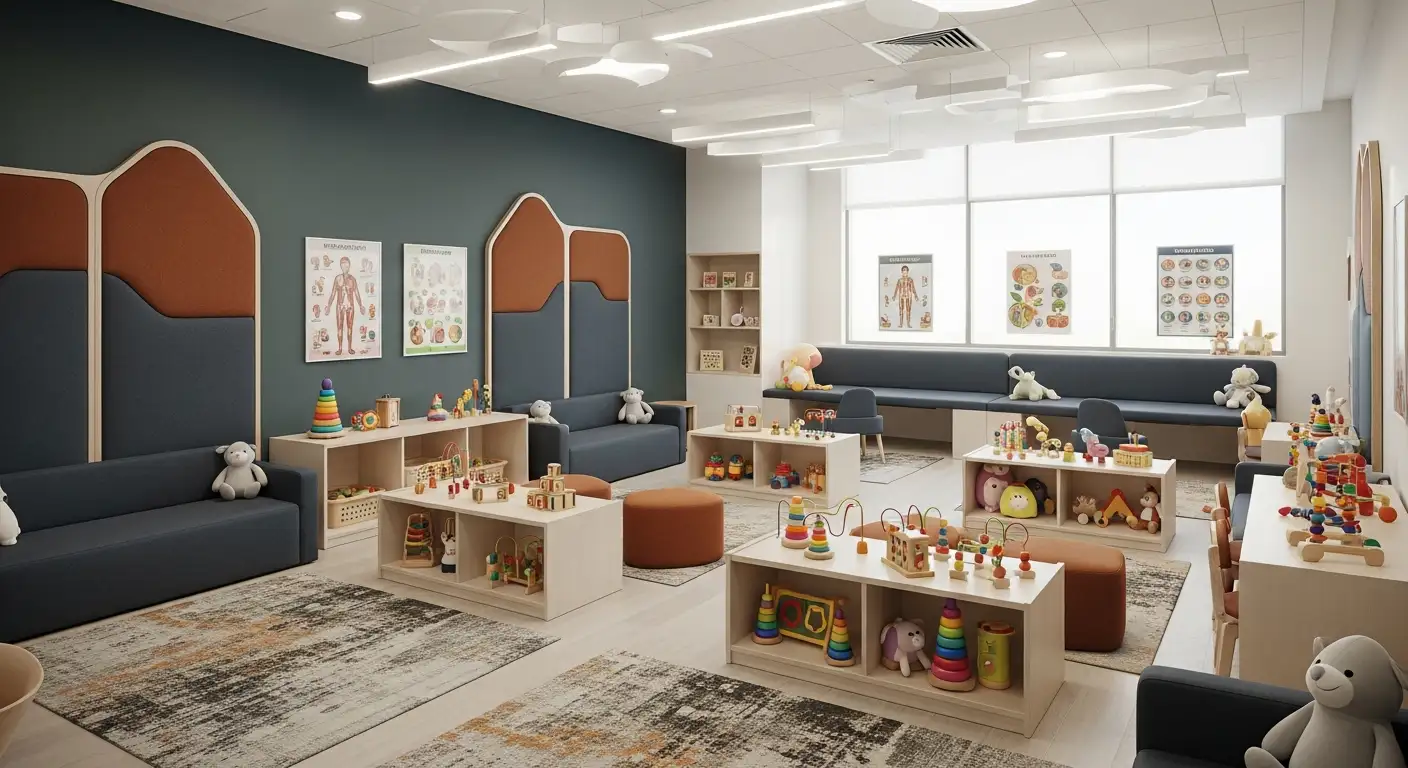How Do You Help a 2 Year Old with Autism


Understanding the Importance of Early Support
Helping a 2 year old with autism involves early diagnosis, multidisciplinary interventions, and family engagement to harness the brain's plasticity and improve social, communication, and developmental outcomes. Starting targeted therapies during this crucial period can significantly enhance a child's quality of life and long-term potential.
Recognizing Autism in a 2 Year Old: Early Diagnosis Matters

Signs of Autism in Toddlers
Autism spectrum disorder (ASD) can sometimes be identified before the age of two. Parents might notice delays or differences in social interaction, communication, and repetitive behaviors. Early signs include limited eye contact, lack of response to name, delayed speech, reduced gestures like pointing, and repetitive movements.
Importance of Early Diagnosis
Early diagnosis is crucial because interventions started at or before preschool age, when the brain is highly plastic, can have significant long-term positive effects. Children who receive early intervention often develop skills that improve communication, social interaction, and adaptive behaviors, increasing their chances of thriving later in life.
Developmental Regression
Some toddlers may initially develop typically but then experience developmental regression, where previously acquired skills such as language or social engagement diminish. This regression is a red flag that should prompt immediate evaluation.
Diagnostic Process for ASD
Diagnosing autism relies on careful observation of social, communication, and behavioral development as there is no specific medical test for ASD. Specialists assess developmental milestones, family history, and behaviors across multiple settings. Early diagnosis enables tailored intervention plans, maximizing the child's potential for progress.
The Role of Early Intervention: Capitalizing on Brain Plasticity

How Does Brain Plasticity in Toddlers Affect Autism Intervention?
Brain plasticity refers to the brain's remarkable ability to reorganize itself by forming new neural connections, especially during early childhood. In toddlers, this plasticity is at its peak, making the early years a critical window for interventions aimed at supporting developmental growth and skill acquisition in children with autism spectrum disorder (ASD).
What is the Ideal Timing and What Benefits Does Early Intervention Offer?
Early intervention ideally begins before or around preschool age, typically between 2 to 3 years old. Intervening during this timeframe takes advantage of the brain's plasticity to maximize developmental gains. Starting therapies early can significantly improve social, communication, and cognitive abilities, enhancing overall quality of life.
What Are the Long-term Positive Effects of Early Intervention?
Children receiving early intervention often show substantial progress that can lead to independence and improved adaptive skills. In some cases, the improvements are so pronounced that children may no longer meet the diagnostic criteria for autism later in life. Early intervention supports development across physical, social, emotional, thinking, and communication domains akin to typical developmental milestones achieved in the first two years of life.
What Are Examples of Early Intervention Programs?
Several well-established programs combine behavioral and developmental principles, including:
- Early Start Denver Model (ESDM): Integrates behavioral and developmental approaches to improve language, social engagement, and cognitive skills.
- Applied Behavior Analysis (ABA): Uses techniques such as Discrete Trial Training (DTT) and Pivotal Response Treatment (PRT) to reinforce positive behaviors.
- Speech and Language Therapy: Targets verbal and nonverbal communication skills.
- Occupational Therapy: Enhances daily living skills and sensory processing.
- Physical Therapy: Improves motor coordination and muscle control.
Family training and involvement are core components of these programs, ensuring consistency and reinforcing skills in everyday environments.
Combining these therapies early in a child's life harnesses neural flexibility, setting a foundation for long-term developmental improvements and greater participation in daily and social activities.
Applied Behavior Analysis (ABA) Therapy: A Foundational Approach

What are the principles of ABA therapy?
Applied Behavior Analysis (ABA) is a well-established, evidence-based behavioral approach that encourages desired behaviors and reduces unwanted ones. The therapy focuses on reinforcing positive actions to improve social interactions, communication, and life skills. ABA operates by breaking down complex behaviors into smaller, manageable parts that can be taught systematically.
What techniques are used in ABA therapy?
Among ABA techniques, Discrete Trial Training (DTT) and Pivotal Response Training (PRT) stand out. DTT is highly structured and involves teaching specific skills in small steps through repeated trials. PRT, on the other hand, is a play-based method that targets pivotal areas such as motivation and response to multiple cues, encouraging natural learning.
What are the goals of ABA in young children?
ABA therapy aims to help young children with autism develop critical skills in communication, social interaction, and daily living. By focusing on these foundational areas, ABA promotes greater independence and reduces behaviors that interfere with learning and socialization. Early intervention with ABA can lead to significant improvements that enhance long-term outcomes.
How is ABA tailored to individual needs?
ABA interventions are customized to each child's unique strengths and challenges. Therapists design individualized treatment plans with specific goals and preferred teaching methods. This personalization ensures that the therapy is relevant and effective for a child’s age, abilities, and developmental level.
| Topic | Description | Importance in ABA |
|---|---|---|
| ABA Therapy Principles | Reinforcing desired behaviors and reducing undesired ones through structured learning | Foundation of all ABA-based interventions |
| Discrete Trial Training (DTT) | Structured, repetitive teaching method focusing on specific skills | Effective for teaching discrete, measurable skills |
| Pivotal Response Training (PRT) | Play-based, motivational approach targeting pivotal developmental areas | Encourages natural progression and engagement |
| Goals in Young Children | Develop communication, social skills, and independence | Critical for early developmental success |
| Individualized Treatment Plans | Personalized strategies and objectives tailored to each child’s needs | Maximizes therapy effectiveness |
Developmental Therapies: Speech, Occupational, and Physical Therapy
What is Speech and Language Therapy?
Speech and language therapy focuses on enhancing both verbal and nonverbal communication skills in children with autism spectrum disorder (ASD). This includes improving speech rhythm, expanding vocabulary, describing feelings, and employing alternative communication methods such as sign language or picture communication systems. By targeting communication challenges early, speech therapy fosters social interaction and supports language development critical for everyday life.
How Does Occupational Therapy Support Daily Living and Sensory Integration?
Occupational therapy helps children develop essential daily living skills like feeding, grooming, and dressing, often making use of assistive devices tailored to the child's unique needs. Additionally, it addresses sensory processing issues through sensory integration therapy, enabling children to better tolerate and respond to sensory input. This therapy promotes independence and improves quality of life by helping children manage everyday tasks and sensory challenges effectively.
What Role Does Physical Therapy Play in Autism Treatment?
Physical therapy concentrates on improving motor skills such as posture, muscle control, coordination, and balance. These motor skills are vital not only for physical confidence but also for social participation. Enhanced motor abilities can enable children to engage more fully in play and learning activities, supporting their overall physical and social development.
How Are Behavioral and Developmental Approaches Combined?
Many successful autism interventions integrate behavioral therapies like Applied Behavior Analysis (ABA) with developmental therapies such as speech, occupational, and physical therapy. For example, the Early Start Denver Model (ESDM) blends behavioral techniques with developmental skills training to optimize outcomes in language, social, and cognitive areas. Combining these approaches offers a holistic treatment plan addressing multiple facets of a child's growth.
| Therapy Type | Focus Areas | Benefits |
|---|---|---|
| Speech Therapy | Communication skills, alternative communication | Enhances verbal/nonverbal interaction |
| Occupational Therapy | Daily living skills, sensory integration | Promotes independence and sensory regulation |
| Physical Therapy | Motor skills, coordination, balance | Improves physical confidence and social participation |
| Behavioral Therapy (ABA) | Behavior modification, skill acquisition | Reinforces positive behaviors and reduces challenges |
Together, these developmental therapies provide a comprehensive support system that fosters the child's communication, independence, motor abilities, and overall well-being.
Social Skills Development: Building Emotional and Relational Foundations
What are social-relational approaches like DIR (Floor Time) and RDI?
Social-relational methods focus on nurturing a child's ability to connect emotionally and form meaningful relationships. DIR, commonly known as Floor Time, encourages parents and therapists to engage with children at their developmental level through play and emotional exchange. RDI (Relationship Development Intervention) guides families to create dynamic interactions that foster social problem-solving and flexible thinking, fundamental for social growth.
How do social stories and social skills groups help?
Social stories use simple, clear narratives to teach children how to interpret social cues and respond appropriately in different situations. Social skills groups offer a supportive environment where children practice interactions with peers, learn to initiate conversations, and read nonverbal signals—all crucial elements for building friendships and improving social confidence.
How do these approaches enhance emotional bonds and peer interactions?
By focusing on emotional connection and practical social experiences, these interventions strengthen a child's ability to relate to others. This support not only improves communication with peers but also deepens emotional bonds within families, enabling children to develop trust and empathy essential for their social and emotional development.
Educational Approaches: Creating Structured and Visual Learning Environments
What is the TEACCH Model?
The TEACCH approach is an educational strategy designed specifically for children with autism spectrum disorder (ASD). It emphasizes structured teaching that adapts classroom settings to each child's unique learning style, often highlighting visual supports and predictable routines. This enables children with autism to engage more effectively with their environment.
How Do Visual Supports and Routine Help?
Visual supports, such as picture schedules, labels, and organized workstations, help children understand what to expect throughout their day. Combining these visual cues with consistent routines reduces anxiety and enhances independent functioning. Clear structure promotes focus and aids learning in children who may struggle with verbal instructions.
How Are Learning Environments Adapted for Toddlers with Autism?
For toddlers, educational spaces are tailored to be calming, predictable, and visually accessible. Materials and activities are organized to encourage exploration within a defined space, fostering developmental skills in communication, social interaction, and play. Early adaptation ensures children feel secure as they build foundational skills.
What Role Do Educational Strategies Play in Early Childhood?
Educational approaches serve as a critical platform for early intervention, supporting cognitive and social skill development during a period of high brain plasticity in young children. By integrating structured teaching methods like TEACCH with family involvement and other therapies, educational strategies contribute significantly to improved long-term outcomes for toddlers with ASD.
Family Involvement: Empowering Caregivers for Consistent Support
Why is family training important in autism intervention?
Family training plays a crucial role in early intervention for children with autism spectrum disorder (ASD). Parents and caregivers learn strategies to reinforce therapy goals, effectively support skill development, and respond to their child's unique needs. This knowledge empowers families to extend therapeutic progress beyond scheduled sessions into everyday life, enhancing consistency and overall outcomes.
How can structured routines at home benefit a child with autism?
Creating structured routines helps children with ASD develop a sense of predictability and security. Consistent daily schedules reduce anxiety, improve behavior, and support learning by providing repeated opportunities to practice new skills. Structured routines at home align with approaches used in therapies like Applied Behavior Analysis (ABA) and TEACCH, reinforcing progress made in clinical and educational settings.
What role do visual supports play in reinforcing therapy goals?
Visual aids such as schedules, picture communication systems, and social stories serve as powerful tools for children with autism. They help clarify expectations, facilitate communication, and encourage independence. Families using visual supports can consistently prompt and reinforce desired behaviors and skills, ensuring therapy techniques are meaningful and integrated into daily routines.
How can families manage caregiver stress and burnout?
Supporting a child with ASD can be demanding, making caregiver stress a significant challenge. Families benefit from accessing support groups, respite care, and professional counseling to maintain their well-being. Shared knowledge, collaboration with therapy teams, and self-care strategies help prevent burnout, allowing caregivers to remain effective advocates and consistent partners in their child's treatment journey.
Managing Co-occurring Medical and Behavioral Conditions
What are common associated conditions in children with autism?
Children with autism spectrum disorder (ASD) often face additional medical and behavioral challenges. Common co-occurring conditions include anxiety, sleep disorders, attention-deficit/hyperactivity disorder (ADHD), irritability, and aggression. These can greatly affect a child's daily functioning and overall well-being.
How are medications used in managing these conditions?
While there are no medications that treat the core symptoms of autism, medications may be prescribed under careful medical supervision to manage associated symptoms. For example, medications can help reduce high energy levels, improve focus, manage anxiety or depression, control seizures, and address gastrointestinal problems. Medication is always part of a broader, individualized care plan.
What behavioral and environmental strategies support symptom management?
Behavioral therapies, particularly those based on Applied Behavior Analysis (ABA), play a vital role in managing co-occurring challenges. Environmental modifications, such as establishing structured routines and using visual supports, can help reduce anxiety and improve attention. Lifestyle strategies including consistent sleep schedules, sensory integration techniques, and family involvement further support symptom management. Combining these approaches with medical treatment creates a comprehensive support system.
Managing these conditions requires a multidisciplinary team approach, personalized plans, and ongoing collaboration between healthcare providers, therapists, families, and educators to optimize developmental outcomes and quality of life.
Psychological Therapies: Cognitive Behavioral Therapy for Emotional Regulation
What is the role of CBT in managing anxiety and emotional challenges?
Cognitive Behavioral Therapy (CBT) is a psychological approach designed to help individuals with autism spectrum disorder (ASD) manage emotions such as anxiety and depression. Children with ASD often face difficulties with emotional regulation and social challenges, making CBT an effective method to reduce anxiety and improve coping skills.
How is CBT customized for young children with autism?
CBT interventions are tailored to meet the developmental levels of young children with Autism. Therapists use simplified language, visual supports, and interactive activities to make sessions engaging and understandable. Treatment plans focus on building emotional awareness and social problem-solving skills, helping children recognize and respond to their feelings appropriately.
How does CBT complement other therapies?
CBT works alongside behavioral and developmental therapies to provide a comprehensive approach to autism treatment. While Applied Behavior Analysis (ABA) focuses on behavior modification and social skills, CBT addresses the internal emotional states. This combination supports better overall outcomes by targeting both external behavior and emotional health, enhancing the child’s ability to function and adapt in various settings.
Nutritional Support: Addressing Dietary Needs and Sensitivities
Importance of nutrition therapy
Nutrition therapy plays a vital role in the comprehensive care of children with autism spectrum disorder (ASD). Many children with ASD face unique digestive issues or food sensitivities that can affect their behavior and overall health. Addressing these nutritional challenges helps support their well-being and can improve their responsiveness to other therapies.
Managing food sensitivities and gastrointestinal issues
Children with ASD often experience gastrointestinal problems such as constipation, diarrhea, or food intolerances. Common sensitivities include reactions to gluten or casein proteins, which some families choose to limit or eliminate in their child’s diet. While dietary changes are not cures for autism, these adjustments can reduce discomfort and behavioral difficulties linked to digestion.
Developing personalized meal plans
Nutrition therapy involves creating individualized meal plans tailored to each child’s preferences, needs, and medical conditions. Careful planning ensures they receive sufficient nutrients while accommodating sensory sensitivities that might influence food acceptance. Working closely with healthcare professionals, therapists, and dietitians helps families implement strategies that balance nutrition with enjoyment and routine.
Proper nutritional support complements behavioral and developmental interventions and enhances a child's capacity to thrive both physically and socially.
Integrating Complementary Therapies: Benefits and Cautions
What Are Common Complementary Therapies for Children with Autism?
Families of children with autism spectrum disorder (ASD) sometimes explore complementary therapies alongside conventional treatments. Popular options include art therapy and music therapy, which encourage self-expression and emotional engagement through creative activities. Mindfulness and relaxation techniques help reduce anxiety and improve emotional regulation by promoting calm and focus.
Why Is Professional Consultation Important?
While these complementary treatments can offer emotional and sensory benefits, consulting healthcare professionals is essential before starting any new therapy. Professionals help ensure the chosen therapies suit the child's individual needs, avoid conflicts with ongoing treatments, and monitor for any adverse effects.
What Should Families Know About Evidence and Safety?
The evidence supporting complementary therapies varies; some have limited scientific backing while others serve mainly as supportive or recreational activities. It is important to recognize that none of these therapies cure autism or replace evidence-based interventions such as Applied Behavior Analysis (ABA) or speech therapy.
Some alternative treatments may be ineffective or potentially harmful if used improperly. Thus, safety, reliability, and thorough research should guide therapy decisions.
By integrating complementary therapies thoughtfully and under professional guidance, families can enrich their child's developmental experience without compromising safety or effectiveness.
Multidisciplinary Teamwork: Coordinating Care for Comprehensive Support
Building a team of specialists
Effective early intervention for autism involves assembling a multidisciplinary team tailored to each child's unique needs. This team typically includes specialists such as behavior therapists (often utilizing Applied Behavior Analysis), speech and language therapists, occupational and physical therapists, as well as medical professionals who manage co-occurring conditions. Social skills trainers and psychologists may also be part of this collaborative effort to address emotional and behavioral challenges.
Keeping detailed evaluations and progress records
Maintaining thorough documentation of evaluations, therapy sessions, and developmental progress is crucial. These records enable the team to track outcomes, adjust treatment plans as necessary, and ensure continuity of care. It also facilitates communication among team members and supports informed decision-making to optimize therapy effectiveness.
Benefits of coordinated care and individualized plans
Coordinated care helps unify goals across therapies, promoting consistent support for the child's communication, social skills, and daily living abilities. Individualized treatment plans reflect the child's strengths and challenges, enabling focused interventions. Family involvement in this teamwork enhances consistency and supports generalization of skills across settings. Overall, a well-coordinated multidisciplinary approach improves developmental outcomes and quality of life for children with autism.
Looking Ahead: Supporting Transitions and Lifelong Development
Planning from Early Childhood to Adulthood
Supporting individuals with autism is a lifelong journey that begins with tailored interventions during early childhood and continues through adolescence into adulthood. Early intervention programs not only aim to build foundational skills in communication, socialization, and daily living but also prepare children and families for future transitions. Planning includes developing independence, vocational skills, and strategies to manage social and emotional challenges. Structured routines and personalized goals established in early years lay the groundwork for smoother shifts into adult roles.
Support Groups and Ongoing Education for Families
Families play a crucial role in the success of intervention and support efforts. Joining support groups enables families to connect with others facing similar challenges, share resources, and receive emotional support. Ongoing education provides caregivers with up-to-date information on autism, behavioral strategies, and ways to advocate for their child's needs. By fostering a strong support network, families can better manage caregiver stress and burnout while promoting consistent progress at home and in the community.
Staying Updated on Emerging Therapies
The field of autism intervention is continually evolving with new research and therapies emerging. Staying informed about advances in evidence-based treatments allows families and professionals to adapt strategies as needed and access novel options that may enhance outcomes. While some complementary approaches offer additional benefits, it remains essential to consult medical and therapeutic experts to ensure safety and efficacy. Proactive learning and collaboration among multidisciplinary teams ensure that individuals with autism receive comprehensive, up-to-date care throughout their lives.
Empowering Toddlers with Autism Through Early, Tailored Support
Helping a 2 year old with autism requires early diagnosis, a multidisciplinary array of evidence-based therapies, and committed family involvement. By combining behavioral approaches like ABA, developmental therapies, social skills training, and addressing medical and nutritional needs, caregivers and professionals can foster growth in communication, socialization, and daily functioning. Early, personalized, and consistent intervention can open the door to significant developmental progress, improved quality of life, and a supportive foundation for lifelong learning and independence.
References
- Treatment and Intervention for Autism Spectrum Disorder
- Early Intervention for Autism | NICHD
- Autism Treatments, Interventions, and Therapy Options
- Interventions and Treatments for Autism in Kids | Inclusive ABA
- Autism spectrum disorder - Diagnosis and treatment
- Treatment for Autism in Kids: Therapies and Their Benefits
Recent articles

Speech Apraxia and Autism
Understanding the Intersection of Speech Apraxia and Autism Spectrum Disorder

Physical Therapy for Strengthening Core Stability in Children
Enhancing Children's Core Strength: The Role of Physical Therapy

Types of Speech Therapists
Exploring the Diverse Roles Within Speech Therapy

How ABA Therapy Can Help with Transitioning Between Activities
Navigating Change: ABA Therapy's Role in Easing Activity Transitions for Children

Communication Milestones
Tracking Early Communication Skills: A Guide to Developmental Milestones

Sensory Integration Therapy & Autism
Understanding the Role of Sensory Integration Therapy in Autism Care


